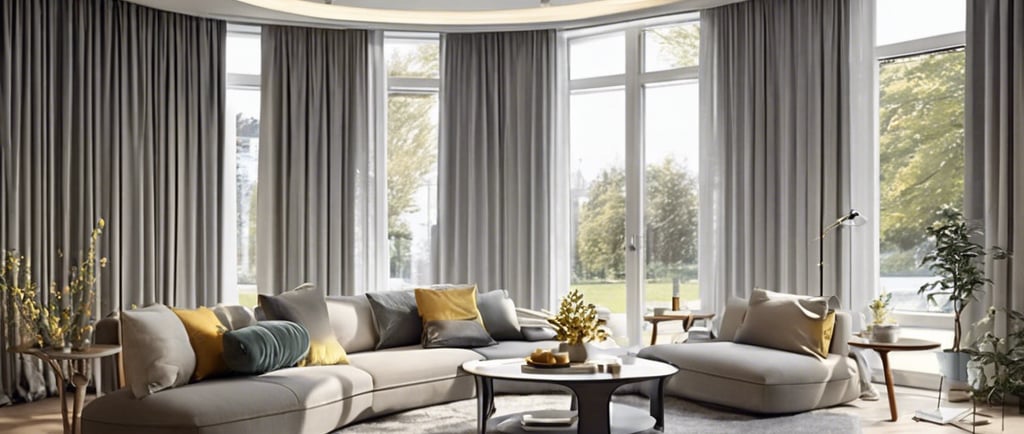Thermal Curtains: The Technology Behind Energy-Efficient Fabric Construction
11/27/20244 min read


Understanding Thermal Curtains
Thermal curtains are a specialized type of window treatment designed to enhance energy efficiency by regulating indoor temperatures. Unlike regular curtains, which primarily serve decorative purposes, thermal curtains are constructed using materials that possess insulating properties. These curtains typically feature multiple layers, including a dense fabric layer combined with a thermal backing, which helps to minimize heat transfer. This function makes thermal curtains an essential consideration for homeowners and office managers aiming to reduce energy consumption and improve comfort levels.
The primary purpose of thermal curtains is to create a barrier against the outdoor elements, thereby keeping interiors warm during colder months and cool in the summer. This insulation ability means that thermal curtains can help reduce reliance on heating and cooling systems, leading to lower energy bills. Users can find various types of thermal curtains available on the market, differing in material and design. Common options include polyester, cotton, and even blends that feature specialized thermal materials. Each of these fabrics contributes to a curtain’s overall thermal performance, making them suitable for varied climates and settings.
Beyond their functional advantages, thermal curtains also offer a range of aesthetic benefits. Available in multiple colors, patterns, and designs, they can complement the decor of any room while still providing energy-saving features. This versatility makes them a popular choice for both residential and commercial spaces. Furthermore, thermal curtains can enhance privacy and block out light, providing a more comfortable environment for relaxation or work. Therefore, while their primary function revolves around energy efficiency, their supporting benefits cannot be overlooked, positioning thermal curtains as an advantageous addition to any home or office.
The Science of Insulation: How Thermal Curtains Work
Thermal curtains are more than just aesthetically pleasing window treatments; they represent a sophisticated means of energy conservation. Their ability to efficiently insulate a space derives from the scientific principles of heat transfer, which includes conduction, convection, and radiation. Understanding these concepts is essential to appreciate how thermal curtains function to minimize energy loss during both heating and cooling processes.
Conduction refers to the direct transfer of heat through materials. In the context of thermal curtains, the fabric's construction plays a pivotal role. These curtains typically comprise multiple layers, where each layer contributes to minimizing heat flow. For instance, denser materials serve as effective barriers against conductive heat transfer, significantly reducing the warmth escaping a room during winter months.
Convection involves the movement of heat through air as it circulates. Thermal curtains are strategically designed to remain close to the window surface, thereby reducing air movement. When installed, they create a pocket of still air between the window and the curtain, which acts as an insulating barrier. By limiting air circulation, thermal curtains help maintain a stable indoor temperature and prevent drafts.
Radiation, on the other hand, involves the transfer of heat through electromagnetic waves. High-quality thermal curtains are often constructed with reflective materials that can bounce back radiant heat energy. This feature is particularly useful during summer months when heat from sunlight enters a home. By reflecting incoming heat, these curtains significantly lower the demand for air conditioning.
The construction of thermal curtains incorporates various technologies aimed at enhancing insulation. Advanced fabric materials may combine layers of thermal mass that absorb and store heat, effectively regulating indoor temperatures. Furthermore, the degree of reflectivity and the overall density of these fabrics are critical in maximizing their insulation properties, ensuring that homes remain energy-efficient irrespective of external climatic conditions.
Materials and Technology in Thermal Curtain Fabrication
Thermal curtains are increasingly becoming a popular choice for homeowners seeking energy efficiency. The effectiveness of these curtains is largely dependent on the materials used in their construction and the advanced technology that enhances their performance. Key fabric types prevalent in thermal curtains include polyester, which is renowned for its durability and resistivity to wrinkling. Polyester is often combined with other materials to bolster its thermal capabilities, making it an ideal choice for energy-efficient window treatments.
Another prevalent fabric in the making of thermal curtains is blackout lining. This material plays a pivotal role in blocking out light and minimizing external temperature fluctuations, directly influencing the thermal performance of curtains. Blackout linings are usually made from tightly woven fibers, which add an extra layer of insulation. Moreover, specialized composite materials, designed specifically for thermal efficiency, have gained traction. These fabrics consist of multiple layers that trap air, creating a barrier that significantly reduces heat transfer.
Recent advancements in fabric technology have further improved the energy efficiency of thermal curtains. Innovative coatings and treatments, such as reflective layers and thermal barriers, have been developed to enhance the thermal retention of these fabrics. Reflective coatings work by reflecting radiant heat away from the window during hot months and keeping warmth inside during cold months, thereby reducing energy costs. Additionally, some manufacturers are now focusing on sustainable practices in their production processes. The use of recycled materials and eco-friendly dyes not only lessens the environmental impact but also resonates with a growing consumer preference for greener options.
In selecting thermal curtains, it is imperative to consider not only the type of fabric used but also the technology applied in its development. Understanding the interplay between materials and energy efficiency can assist consumers in making informed choices that contribute to both comfort and cost savings.
Choosing and Installing Thermal Curtains for Maximum Efficiency
When selecting thermal curtains, it is essential to consider various factors to ensure they meet specific requirements and maximize energy efficiency. Firstly, climate plays a significant role in determining the types of thermal curtains most suitable for a home. In colder regions, selecting curtains with a high thermal resistance or insulation level can significantly assist in retaining heat during colder months, while lighter fabrics may be more appropriate for warmer climates to prevent overheating.
Window size and design also influence the choice of thermal curtains. For optimal effectiveness, curtains should be slightly wider and longer than the window itself, allowing for full coverage and proper insulation. This ensures that gaps are minimized, thus preventing drafts and heat loss. It is advisable to measure the windows accurately, accounting for any hardware, such as curtain rods, to ensure a perfect fit. Additionally, selecting curtains in colors and patterns that complement the existing home decor can enhance aesthetics without compromising functionality.
Proper installation techniques play a crucial role in optimizing the performance of thermal curtains. It is important to hang them as close to the ceiling as possible and ensure that they extend to the floor for maximum coverage. This configuration helps to trap air and create an insulating barrier against temperature fluctuations. Regular maintenance is essential to prolong the lifespan and effectiveness of thermal curtains. Dusting them regularly and following the manufacturer’s cleaning instructions will ensure they remain in optimal condition. By incorporating high-quality thermal curtains, homeowners can expect potential energy savings through reduced heating and cooling costs, contributing to an assured return on investment over time.
Curtains&Fabrics
Design,production,sales,service in curtain fabrics&curtians.
Quality
Products
sales01@anytextile.com
+8615968501933
© 2024. SHAOXING LEYAO IMPORT AND EXPORT CO.LTD All rights reserved.
